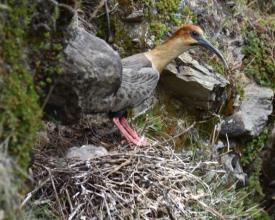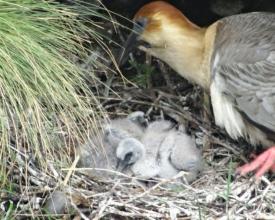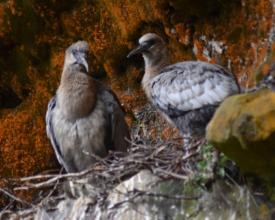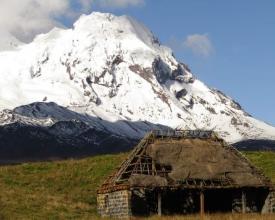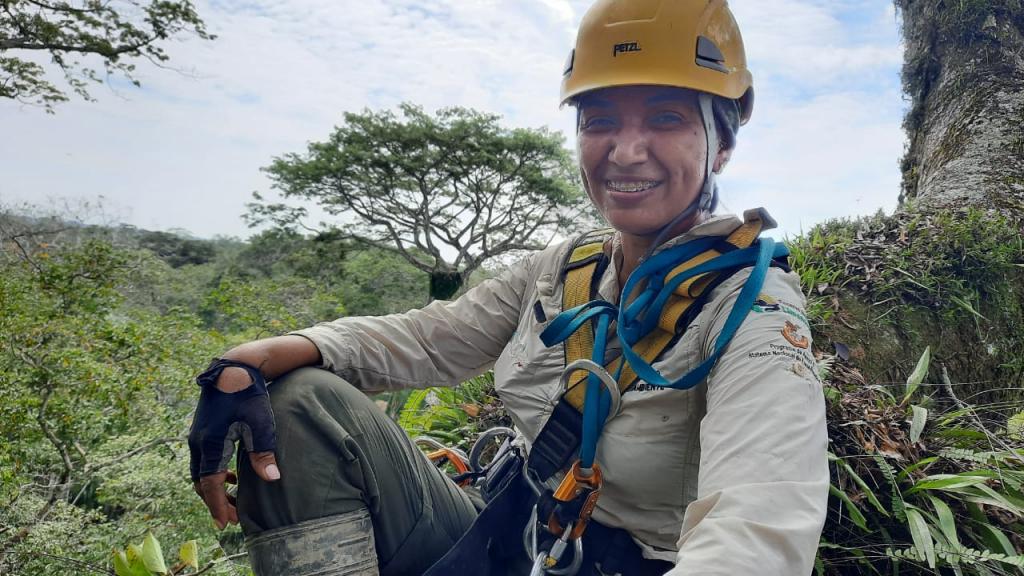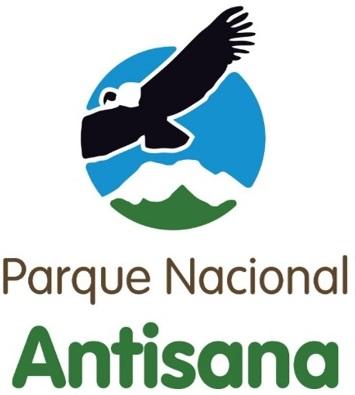
Protecting water sources to conserve the Andean Bandurria in Antisana National Park
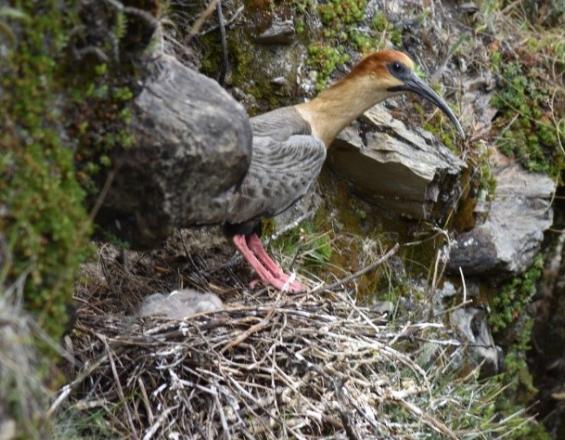
The Mica area of Antisana National Park is one of the habitats of the Andean Bandurria (Theristicus branickii). This species is in the category of Near Threatened (NT) according to the IUCN Red List of Threatened Species and Critically Endangered (CR), according to the National Red List of Continental Birds of Ecuador.
In 2016, the first census of this species was conducted, in which 80 specimens were counted; as a result of this first event, a biological monitoring process began in 2017. In this study period, two roosting sites (roosts) and two additional nesting points next to a river "correntoso Antisana" were identified. The behavior of the species led to a preliminary hypothesis that water and the location on rocky walls is very important for the successful rearing of their chicks, as they become natural barriers to predators (hawks, giant owls and caracaras).
Context
Challenges addressed
- The Andean Bandurria, despite being a species present in Antisana National Park, at first had not been considered a conservation value, until the 2016 census, which yielded a population of 80 specimens nationwide.
- The knowledge of the biology of the species was another of the limitations that were found because there was very little information from studies, and in the case of Antisana National Park, none.
- Already in the study process, and given the particularity of the roosting habits (roosts) and nesting sites, which are basically rock walls next to waterfalls; monitoring with the implementation of camera traps was a real challenge, because the staff had limited knowledge about rock climbing; however, this was the first challenge to overcome with the training of the staff.
One of the biggest challenges of the research, and certainly for this species, is presumably the affectation of the optimal ecosystem for reproduction.
Location
Process
Summary of the process
For the protection and conservation of the Andean Bandurria, coordination mechanisms were established with local stakeholders to carry out control and surveillance actions at sites with anthropic pressure, as well as monitoring compliance with water capture and transport quotas, guaranteeing the ecological flow (Pillar 1).
Research is a main axis; in this context, academia and institutional partners are invited to participate in research on the Andean Bandurria and water resources, which consolidate the management of the NAP. In addition, users and the local community are invited to participate in the field days, which strengthens their identity and knowledge of the conservation values of the PNA. (Pillar 2).
Environmental education and awareness is a vital activity for the conservation of the habitat of the Andean Bandurria and the water resource. With the support of allied institutions and the local community, educational talks, field trips and construction of interpretive infrastructure are carried out so that tourism is an orderly activity that respects the conservation values of the ANP and supports local communities economically (Pillar 3).
Building Blocks
A look at governance, linking local stakeholders and users to strengthen management
The participation of various community and institutional stakeholders improves the management of protected areas and strengthens their governance.
Enabling factors
- Establishment of the principle of participatory conservation with a landscape approach for a threatened species such as the Andean Bandurria shared with other stakeholders.
- Maintaining good relations with communities and institutions in the buffer zone as part of the participatory governance process.
Lesson learned
- The conservation of endangered species within a protected area is not only the responsibility of its administration; it demands the attention of all community and institutional actors, which is why it is vitally important to coordinate actions with the actors involved in the conservation and use of environmental services.
- The use of natural resources and their ecosystem services must take into account the potential impacts on natural ecosystems in general and endangered species in particular.
Research for the safeguarding of natural heritage
The generation of first-hand information is fundamental for making the right decisions, especially when there are reduced populations of threatened species, as is the case of the Andean Bandurria.
Enabling factors
- Development of a monitoring program for a threatened species based on well-defined protocols and with scientific technical support.
- Training of park ranger personnel for the regular and constant collection of information with the technical support of research institutions with extensive experience in monitoring threatened bird species.
Lesson learned
- Monitoring and research on the Andean Bandurria has identified that the reproductive success and survival of this species is dependent on stable water sources.
- The population growth of large cities and the demand for water is increasing. In this scenario, it is a priority to protect, restore and conserve the moorlands and their biodiversity, particularly the Bandurria as an indicator species of stable water flows at the source.
Education and awareness
Scientific/technical information associated with biodiversity monitoring should be shared with the population to generate environmental awareness and support for protected area management.
Enabling factors
- Periodic collection of information and its adaptation so that it can be disseminated and understood by a broad group of target audiences.
- Permanent feedback between specialists and researchers and the personnel responsible for dissemination and environmental education in order to have updated information that can be shared.
- Generation of public awareness about the dangers that may affect endangered species within protected areas.
Lesson learned
- Environmental education and awareness is a very important tool to strengthen actions to protect and conserve the páramo as a source of water, biological richness and its interdependence.
- Local stakeholders and institutions involved in the management of the protected area need to be permanently informed based on monitoring results and not only on theory.
Impacts
- Inter-institutional commitments have been established between the Antisana National Park and the Empresa de Agua Potable de Quito EPMAPS, in order to respect the minimum flow during the reproduction period of the species from September to March.
- The recovery of the moorland's physical characteristics, structure, and functionality is fundamental after a long history of intensive cattle ranching; in this context, cattle ranching and burning have been reduced by 99%.
- Sites with the greatest negative impact from cattle ranching have been identified, where a process of assisted restoration with native species has been initiated.
- The areas of use have been delimited through the preparation of a zoning map of the protected area, considering the distribution of the Andean Bandurria as sites of strict protection.
- This information generated will help to carry out censuses at specific points and to take measures for the possible recovery of the species' population, as part of the monitoring program and compliance with the Green List Standard.
With information from the Andean Bandurria study, environmental education talks are being given in schools, colleges, universities, and visitors to the protected area, focusing on the protection of moorland ecosystems, water sources, and good water use in the city.
Beneficiaries
MAATE-PNA, 1 drinking water company and approximately 100 families in the communities of Secas, Canteras and El Carmen benefit from tourism as a result of protecting the Andean Bandurria.
Sustainable Development Goals
Story
"Being a descendant of a family that worked in the Antisana hacienda, owned by the Delgado Family, at my young age I was related to cattle raising, the exuberant moorland landscapes, the Andean Condor, the White-tailed Deer, moorland wolves, pumas and undoubtedly the Andean Bandurria.
In my long days of grazing sheep and cattle, under the watchful eye of the imposing Antisana volcano, its icy and melodious winds, I was an eyewitness of large flocks of Bandurrias, long and entertaining stories of my father (+), who had observed flocks of up to 130 specimens, which fed in the plains and wetlands of the Antisana Andean moors.
As time went by, the Bandurria population decreased significantly. This event is directly associated with cattle ranching, since every year the rodeantes, also known as chagras, gathered the herd of cattle for a month for discarding, branding and cures. During the time the rodeo lasted, the chagras fed on cattle, wild animals, including the Bandurria, due to the exquisite flavor of this species. This environment of exuberant natural beauty that contrasted with the anthropic activity, was forming my conservationist character and since 2011 I work as a park ranger.
The decade of the 90's was characterized by the construction of the La Mica reservoir, for the collection, conduction and supply of water to the city of Quito. Due to the demand for water in this city, years later new catchments are made, with the consequent reduction of the flow of two water sources; which directly affected the behavior of the species.
Since 2016, actions have been carried out with the objective of knowing the status of the Andean Bandurria population, distribution and behavior of the species; in this context it has been possible to identify the Bandurria as a conservation value in the Management Plan of the Antisana National Park, updated in July 2021.
Now that the National Park is in the process of certification to the Green List Standard, this Bandurria monitoring initiative will be a sign of progress in the successful results component of protected area management this path of continuous improvement."
Diego Cuichán
